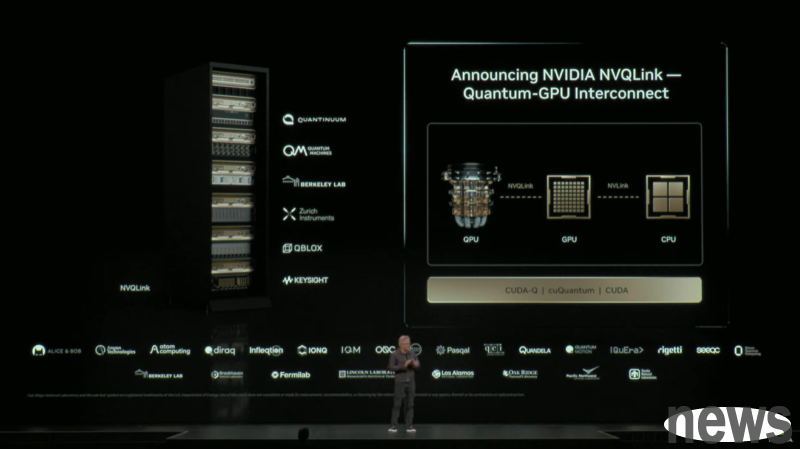In the increasingly accelerating computing field, the development of quantum computing has been hindered by the complexity of networks and control. However, NVIDIA (Nvidia) revealed the NVQLink architecture at GTC in Washington, ushering in the &quo...

In the increasingly accelerating computing field, the development of quantum computing has been hindered by the complexity of networks and control. However, NVIDIA (Nvidia) revealed the NVQLink architecture at GTC in Washington, ushering in the "era of quantum and GPU computing."
NVIDIA NVQLink is hailed as the world's first system that can interconnect quantum systems with traditional central processing units (CPU) and graphics processing units (GPU) systems. It not only overcomes the main obstacles to quantum development, but also lays the foundation for future hybrid accelerated computing.
NVQLink necessity demonstrates the symbiosis of quantum and conventional computingTim Costa, general manager of NVIDIA's engineering, semiconductor and quantum business units, explained the "symbiotic relationship" that exists between quantum computers and traditional computers. On the one hand, quantum processors have the potential to unlock problems that traditional systems cannot solve on their own. But on the other hand, for quantum computers to be useful tools, extremely large computational problems must be solved, especially in terms of error correction, calibration and optimal control.
The scale of quantum processors continues to grow, and the above problems require low latency and high bandwidth to provide a large amount of AI computing power. NVIDIA firmly believes that practical quantum computers will not exist without the application of large-scale AI supercomputers to handle key issues such as simulation, calibration and overall control of quantum devices. Therefore, applying AI to traditional GPU computers on quantum devices is seen as an absolutely necessary milestone towards useful quantum computing.
Currently, error correction is still in its infancy, and calibration is often manually adjusted by physicists. Costa points out that this approach simply doesn't scale to the scale of systems needed to solve practical problems of significant significance. This is the core motivation of NVIDIA launching NVQLink.
For a long time, one of the main obstacles to quantum development has been the networking component that allows a quantum system to communicate with another computing system. Due to the inherent complexity of quantum signals, interconnecting two very different systems, quantum systems and conventional computers, has been an obstacle. While there have been attempts to bridge the gap in the past, such as the University of British Columbia's "Quantum Universal Translator," progress in effectively bridging the two worlds has been limited.
The NVQLink architecture was born to achieve tight integration between quantum processors (QPU) and traditional GPUs. This integration forms the basis of NVIDIA's reciprocal vision of hybrid, accelerated quantum-GPU systems and accelerated quantum supercomputers.
In terms of technical implementation, NVQLink has demonstrated impressive performance breakthroughs:
Ultra-low latency communication: The interconnect enables engineers and scientists to call GPU operations directly from the quantum processor with latency as low as four microseconds. Scalable legacy resources: To further enhance the system, connected GPU systems can be connected via Ethernet to scale to arbitrarily large amounts of computing resources when needed. Broad modal support: NVQLink’s interconnect solutions support all major QPU modalities, spanning technologies from superconducting systems and trapped ions, to photonics and neutral atoms.Costa emphasized that NVQLink represents the most powerful traditional classical resource connected to a quantum processor to date, enabling interconnects with the lowest latency and has demonstrated complete and scalable quantum error correction capabilities.
In addition to breakthroughs in hardware interconnection, NVQLink’s success is also built on NVIDIA’s software ecosystem. The architecture provides instant access to the NVIDIA CUDA-Q software library application programming interface (API) to support operations across GPUs, CPUs and QPUs.
CUDA-Q allows domain scientists to combine all the best techniques for accelerating computing, and the infrastructure they currently use, with the power of quantum processors. NVIDIA's goal is to provide a foundational science and engineering tool for those who are building quantum technologies and to work with all quantum hardware and software developers to integrate them into the systems that will become the future of computing, including quantum acceleration. This also provides powerful computing power to perform important tasks such as error correction, calibration and control.
NVIDIA positions NVQLink as an open architecture system. During development, NVIDIA collaborated with approximately 17 organizations working on quantum processor technology. Institutions listed as partners at GTC include companies such as IonQ, Quantunuum and QuEra, as well as top laboratories such as Fermilab, Los Alamos National Laboratories and Oak Ridge National Laboratories. Costa made it clear that the definition of the architecture, the adoption of the architecture, was done in open collaboration with the ecosystem.
NVIDIA’s strategic mission in launching NVQLink is very clear, which is to create the best classical computing technology to integrate quantum processors, so that the world can solve problems that cannot be solved by classical systems alone..
By providing an efficient, low-latency, high-bandwidth traditional computing bridge, and combining its powerful AI/GPU computing capabilities with the open CUDA-Q software platform, NVQLink not only breaks the physical and network barriers between quantum and traditional computing, but also introduces the ultra-large-scale computing capabilities of AI into the key link of quantum control. This move effectively transforms quantum computing from an isolated academic challenge into a hybrid accelerated computing solution that is scalable, practical and closely integrated with existing supercomputer infrastructure, truly opening the way to realizing useful quantum computing.